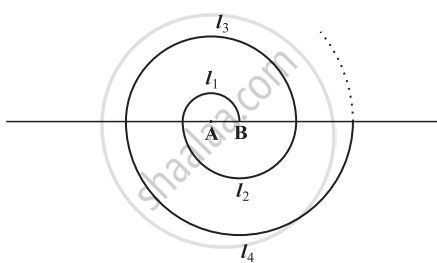Advertisements
Advertisements
प्रश्न
A spiral is made up of successive semicircles, with centres alternately at A and B, starting with centre at A of radii 0.5, 1.0 cm, 1.5 cm, 2.0 cm, .... as shown in figure. What is the total length of such a spiral made up of thirteen consecutive semicircles? (Take `pi = 22/7`)

[Hint: Length of successive semicircles is l1, l2, l3, l4, ... with centres at A, B, A, B, ... respectively.]
उत्तर
Length of a semi-circle
= semi circumference = `1/2 (2pir) = pir`
l1 = πr1 = 0.5 π cm = 1 × 0.5 π cm
l2 = πr2 = 1.0 π cm = 2 × 0.5 π cm
l3 = πr3 = 1.5 π cm = 3 × 0.5 π cm
l4 = πr4 = 2.0 c cm = 4 × 0.5 π cm
l13 = πr13 = 13 × 0.5 π cm = 6.5 π cm
Now, length of the spiral = l1 + l2 + l3 + l4 + ... + l13
= 0.5 π [1 + 2 + 3 + 4 + ... + 13] cm ....(1)
∴ 1, 2, 3, 4, ...., 13 are in AP such that
a = l and l = 13
∴ `S_13 = 13/2 [1 + 13] ....["Using" S_n = n/2 (a + l)]`
= `13/2 xx 14`
= 13 × 7
= 91
∴ From (1), we have:
Total length of the spiral = 0.5 π [91] cm
= `5/10 xx 22/7 xx 91` cm
= 11 × 13 cm
= 143 cm
APPEARS IN
संबंधित प्रश्न
In an A.P., if S5 + S7 = 167 and S10=235, then find the A.P., where Sn denotes the sum of its first n terms.
If the sum of the first n terms of an A.P. is `1/2`(3n2 +7n), then find its nth term. Hence write its 20th term.
Ramkali saved Rs 5 in the first week of a year and then increased her weekly saving by Rs 1.75. If in the nth week, her week, her weekly savings become Rs 20.75, find n.
Find the sum of first 15 multiples of 8.
Find the sum of the following arithmetic progressions:
1, 3, 5, 7, ... to 12 terms
Find the middle term of the AP 6, 13, 20, …., 216.
If (3y – 1), (3y + 5) and (5y + 1) are three consecutive terms of an AP then find the value of y.
Choose the correct alternative answer for the following question .
What is the sum of the first 30 natural numbers ?
The first term of an A. P. is 5 and the common difference is 4. Complete the following activity and find the sum of the first 12 terms of the A. P.
a = 5, d = 4, s12 = ?
`s_n = n/2 [ square ]`
`s_12 = 12/2 [10 +square]`
`= 6 × square `
` =square`
If the 10th term of an A.P. is 21 and the sum of its first 10 terms is 120, find its nth term.
If the sum of three consecutive terms of an increasing A.P. is 51 and the product of the first and third of these terms is 273, then the third term is
If the sums of n terms of two arithmetic progressions are in the ratio \[\frac{3n + 5}{5n - 7}\] , then their nth terms are in the ratio
Q.12
Find the sum of first 10 terms of the A.P.
4 + 6 + 8 + .............
If an = 3 – 4n, show that a1, a2, a3,... form an AP. Also find S20.
Find the sum of numbers between 1 to 140, divisible by 4
If ₹ 3900 will have to be repaid in 12 monthly instalments such that each instalment being more than the preceding one by ₹ 10, then find the amount of the first and last instalment
Find the sum of 12 terms of an A.P. whose nth term is given by an = 3n + 4.
If the last term of an A.P. of 30 terms is 119 and the 8th term from the end (towards the first term) is 91, then find the common difference of the A.P. Hence, find the sum of all the terms of the A.P.
Assertion (A): a, b, c are in A.P. if and only if 2b = a + c.
Reason (R): The sum of first n odd natural numbers is n2.
